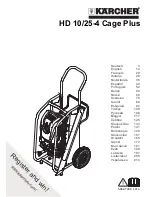
15
Install Vent System
1. Install exhaust hood. Use caulking compound to seal exterior
wall opening around exhaust hood.
2. Connect vent to exhaust hood. Vent must fit inside exhaust
hood. Secure vent to exhaust hood with 4" (102 mm) clamp.
3. Run vent to dryer location. Use the straightest path possible.
See “Determine vent path” in “Plan Vent System.” Avoid 90º
turns. Use clamps to seal all joints. Do not use duct tape,
screws, or other fastening devices that extend into the interior
of the vent to secure the vent, because they can catch lint.
Level Washer/Dryer
Properly leveling your washer/dryer avoids excessive noise and
vibration.
1. Check the levelness of the washer/dryer by placing a level
on the top edge of the washer, first side to side, then front
to back.
2. If the washer/dryer is not level, prop up the front with a wood
block and adjust the feet up or down as necessary. Remove
wood block and lower washer/dryer. Repeat this step until the
washer/dryer is level.
Connect Vent
1. Using a 4" (102 mm) clamp, connect vent to exhaust outlet
in washer/dryer. If connecting to existing vent, make sure the
vent is clean. The vent must fit over the exhaust outlet and
inside the exhaust hood. Make sure the vent is secured to
exhaust hood with a 4" (102 mm) clamp.
2. Move washer/dryer into its final location. Do not crush or kink
vent. Make sure washer/dryer is level.
Complete Installation
1. Check that all parts are now installed. If there is an extra part,
go back through the steps to see which step was skipped.
2. Check that you have all of your tools.
3. Dispose of/recycle all packaging materials. Keep the plastic
foam for use if the washer/dryer should be transported.
4. Check the washer/dryer’s final location. Be sure the vent is not
crushed or kinked.
5. Check that the washer/dryer is level and front leveling feet are
tight. See “Level Washer/Dryer.”
6. For power supply cord installations, plug into an outlet. For
direct wire installation, turn on power.
7. Check that the water faucets are on.
8. Check for leaks around faucets and inlet hoses.
9. Remove the blue protective film on the console and any tape
remaining on the washer/dryer.
10. Read the Washer/Dryer User Instructions.
11. Wipe the dryer drum interior thoroughly with a damp cloth to
remove any dust.
12. To test the washer, measure the normal recommended
amount of detergent and pour it into the washer. Close the lid.
Select the REGULAR cycle and pull out the Cycle Control
knob. Allow the washer to complete one whole cycle.
13. To test the dryer, set the dryer on a full heat cycle (not an air
cycle) for 20 minutes and start the dryer.
If the dryer will not start, check the following:
Controls are set in a running or “On” position.
Start button has been firmly pushed.
Washer/dryer is plugged into a grounded outlet and/or
electrical supply is on.
Household fuses are intact and tight, or circuit breakers
have not tripped.
Dryer door is closed.
14. When the dryer has been running for 5 minutes, open the
dryer door and feel for heat.
If you do not feel heat, turn off the dryer and check the
following:
There may be 2 household fuses or circuit breakers for the
dryer. Check that both fuses are intact and tight, or that
both circuit breakers have not tripped. If there is still no
heat, contact a qualified technician.
NOTE: You may notice an odor when dryer is first heated.
This odor is common when the heating element is first used.
The odor will go away.
1
⁄
2


































